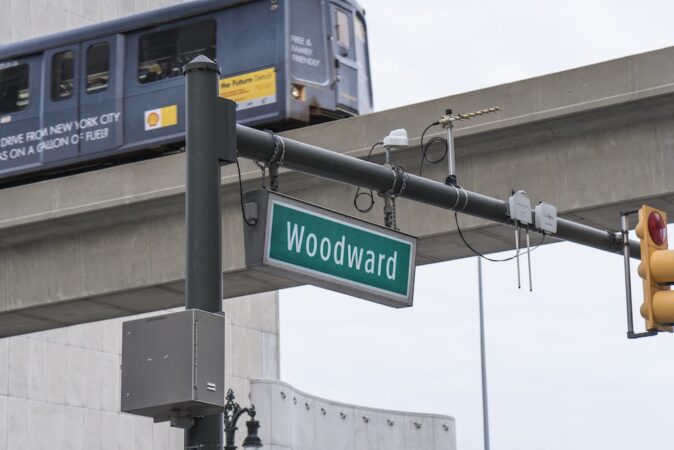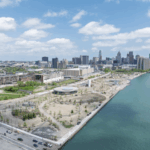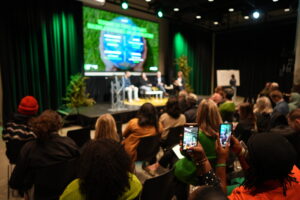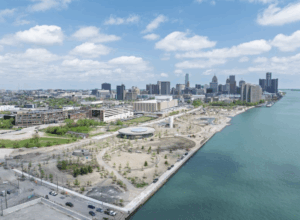As we continue to talk of the transformation of Detroit into a thriving epicenter, driving the future of new mobility has been gaining attention. And with good reason. Given the city’s legacy as the birthplace of the automobile industry, it only makes sense that Detroit would be at the forefront of the next big revolution in transportation. As part of a new ongoing series, Detroitisit takes a deeper look at transportation and mobility in the city and Southeastern Michigan, in hopes of deepening the discussion.
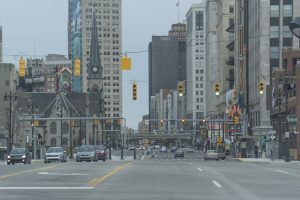
Detroit City Streets. Photo Katai
BREAKING FREE FROM TRADITION
Amid all the buzz about Detroit being transformed into this vibrant metropolis driving the future of mobility, one thing shines through vividly clear — the city is nowhere close to breaking free of the traditional car commute.
Even with all the improvements being made to Detroit’s mass transit system and the budding number of new mobility options springing up in the city, personal vehicles are still the preferred mode of transportation in Southeastern Michigan.
In fact, according to a 2017 Census report, people driving alone in their cars made up 83 percent of all work commutes in Detroit, Warren and Ann Arbor. Those between the ages of 25 to 44 accounted for roughly 34 percent of those work commuters, a sign that a lot of early adaptors in the area are still clinging to their personal automobiles.
In short, people in the “Motor City” — both old and young — can’t seem to get away from the idea of driving their own car. “I like the freedom,” says Dana Harvey, who was born and raised in the city. “I know there are (other) options, but I am used to having a car.”
Jean-Paul Rodrigue, a geography professor at New York’s Hofstra University, who studies urban transportation issues, contends that the flexibility that a personal car offers is still the most preferred form of transportation in the U.S.
“It’s 80 percent of all the mobility around the United States,” says Rodrigue. “People are making a choice, but a car is still the major form of freedom and mobility. And as so they can afford it, they choose that freedom.”
NEW MOBILITY OPTIONS
It’s likely that Detroit’s exciting new mobility movement will prompt a few more Metro Detroiters to swap out those traditional gas guzzling cars for electric vehicles, as companies like Ford and General Motors work to expand the region’s EV charging infrastructures. But the basic appeal of driving one’s own car in Detroit, whether it’s a new Chevy Bolt EV or a 2011 Ford Explorer, is likely to last well beyond the next decade.
Richard Wallace, a transportation analyst with the Michigan-based Center for Automotive Research (CAR), says that the desire to own a car in Detroit, essentially boils down to a matter of convenience.
“Scooters are taking off, as is bike-sharing. Some of these are good only for fairly short distances, not for commuting to a job in Troy or even Southfield,” says Wallace, speaking of some of the areas outside Detroit. “Imagine having to pay Uber or Lyft rates for commuting those everyday distances.”
The inherent challenges of using other modes of transportation in Detroit, aside from a personal car, is something that Joe Maiorana speaks of from a much different perspective than native Detroiters, being a fairly, new resident in the city and one who lives downtown.
“There still is not enough density of retail and restaurants in one area, so cars are pretty useful if you want to go to an area like Midtown, West Village or Indian Village. That absolutely helps on a daily basis,” says the 28-year-old Maiorana, who moved to Detroit from Philadelphia six years ago. “I commute to Bloomfield Hills for work, and there would be no way to do that without a car.”
So, with all that said, the question becomes — what can be done to encourage those longstanding car commuters in Detroit to co-opt other modes of transportation, and how can the region improve the more basic car commute, as Detroit forges ahead on this new path in the world of mobility?
THE PARKING CHALLENGE
Harvey, whose daily commute consists of a 27-mile drive from her home in West Bloomfield to Midtown for work, says that her only major issue with owning a vehicle in Detroit are the challenges associated with parking in the city, specifically in Midtown and the downtown area.
“Parking is becoming more horrendous as the number of businesses grow,” says Harvey. “Parking fees have also been increased. The good thing is there are apps we can use for the parking meters. I use it all the time when I can find it.”
Native Detroiter Maria B. Stanfield, a psychologist and entrepreneur with a number of businesses in Detroit, shares some of the same sentiments. “I think the implementation of using the apps to be able to pay for parking is great,” says Stanfield. “Once you become familiar with it, it’s pretty easy. And I love that you have don’t to pay on Sundays to park downtown.”
For Maiorana, Detroit’s downtown parking issues are even more stressful, as a vehicle owner and resident in the area. “Parking can be quite expensive downtown. They actually seem to be running out of parking spaces,” he says. “If you own a car and live downtown, it’s not the most convenient.”
Of course, when compared to cities like New York where hourly meter parking rates, alone, can run up to $7.50 an hour, parking in Detroit is still relatively feasible. And yet, even with visions of a future where driverless vehicles shuttle people up and down Michigan Ave., finding more innovative solutions to parking, is vital to both the city’s short-term and long-term mobility strategies.
RIDE SHARE
Stanfield believes ride-sharing partnership programs with downtown businesses could help address some of the parking issues, especially when there is a major event being held in the city.
Even better, imagine if some of the desolate plots of land on the outskirts of downtown Detroit were transformed into these bustling 24-hour mobility hubs where commuters could park their automobiles, grab a quick bite to eat and then opt for either a Lyft, a driverless shuttle or a DDOT bus to get to some other destination in the city. The idea has long been a cornerstone of visions of a more modern Rosa Parks Transit Center in downtown Detroit’s central business district, featuring artists and grab-and-go food offerings. But why not make it a more immediate part of the city’s mobility strategy, while plans for converting the old Michigan Central Station into this towering mobility hub are being hammered out.
A similar concept, launched in Bremen, Germany in 2003, which now includes more than 25 transit hubs, has removed 4,200 cars from the road, according to the public interest group, Shared-Use Mobility Center.
FROM THEORY TO PRACTICE
It’s clear, however, that any plans aimed at getting Detroit car owners to co-opt other modes of transportation, are going to require a pretty convincing pitch — especially when trying to sway longtime residents like Harvey. “Maybe it’s just being a Detroiter, and being used to always driving a car,” says Harvey. “I understand that the bikes, the scooters, the QLINE (Detroit’s new street car system) and the ride-sharing are great things that Detroit has been asking for, but it’ll take time.”
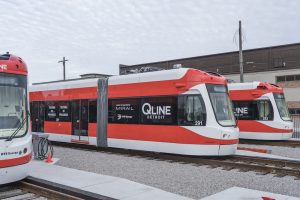
EARLY DAYS OF THE QLINE DETROIT
But as the old adage says, “where’s there’ s a will, there’s a way.” An in-depth study by the research and innovation group, Forum Virium in Helsinki, Finland, unearthed five general concepts that can be used to encourage people to reduce their use of conventional vehicles, with a specific focus on incentives that can be delivered or accessed via a smartphone.
Known as the EMPOWER Project, the recommendations include getting more local companies to encourage their employers to use alternative modes of transportation; a system that allow drivers to collect points with monetary value at local businesses by not driving; creating a campaign that promotes a charity through using alternative modes of transportation like cycling; creating a friendly competitive team scenario for using alternative modes of mobility, perhaps between different local businesses; and an automated approach to mobility monitoring, which makes it easier to track the progress when participating in mobility initiatives.
IMMEDIATE CONCERNS
Of course, those strategies do little to address some of the more immediate concerns for daily drivers in Detroit, which in addition to parking, includes those dreaded potholes and the high cost to insure a vehicle.
Harvey believes that most who own a car and drive in Michigan have simply become accustomed to the rough conditions of the roads. “I think potholes are a thing that we’ve just come to accept, like winter. And there is never an expectation that it will get fixed, but it definitely is an issue,” says the West Bloomfield resident.
Stanfield says she’s actually noticed some efforts being put into repairing the streets and seemed more optimistic about future improvements. “Even on Connor to Warner Ave., they are repaving the roads,” notes Stanfield. However, fixing the exorbitant cost of car insurance in Detroit, which rank as some of the highest premiums in the country, has proven to be far more complex.
Still, it’s important that Detroit stakeholders continue to work to address these more pressing transportation issues, given the current limitations of alternative modes of mobility in the city, which will take some time to address.
“Until we fix our many decades of poor transportation and land use planning, these new mobility options will continue to have only marginal effects and only in select areas such as Midtown,” says Wallace. “We have a great deal of catching up to do with our peer cities…on this front — decades of work ahead.”
Then again, that “catching up” period, which Wallace speaks of, also affords Detroit the unique opportunity to develop urban mobility ideas that are truly sustainable, rather than some glitzy concepts that make for great optics today but are difficult to sustain down the road.



